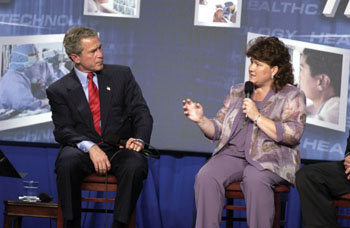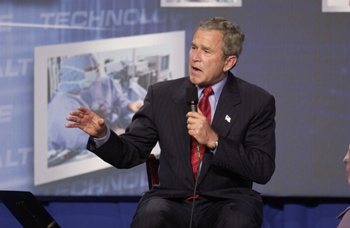
President George W. Bush listens to Jennifer Queen, the mother of a Children’s Hospital patient, during a forum on medical information technology held yesterday at Langford Auditorium. Photo by Daniel Dubois
Technology in health care focus of President Bush’s VUMC visit

In his remarks, Bush was effusive in his praise for Vanderbilt. He spoke before a crowd of 1,000 in Langford Auditorium. Photo by Daniel Dubois
President George W. Bush visited the Monroe Carell Jr. Children’s Hospital at Vanderbilt and later joined a conversation in Langford Auditorium about health care information technology during a two-hour Medical Center visit yesterday.
“There’s no better place to talk about health care than a place that delivers excellent health care — right here at Vanderbilt,” Bush said. “This hospital knows how to use IT [information technology] for the benefit of patients and docs.”
The president learned about Vanderbilt’s strides toward utilizing health care information technology to improve patient care and hospital operations during the afternoon visit.
At the Children’s Hospital, Bush was given a demonstration of Vanderbilt’s hospital clinical information system by Neal Patel, M.D., an attending physician in the Pediatric Critical Care Unit. He served as the co-chair of the information systems design team for the new Children’s Hospital.
Vanderbilt’s computer physician order entry system, WizOrder, helps make the delivery of health care safer, Patel told the president. The technology can help guide drug dosing for patients, check for allergies and provides physicians the tools to make the best decisions possible.
Patel also showed Bush another tool, StarChart, Vanderbilt’s electronic medical record which allows for faster access to patient data such as laboratory values, radiology reports and other information, which traditionally was only available in a paper chart. He also demonstrated PACS, which allows X-rays to be viewed at the bedside or on any computer in the hospital.
“The president is putting [health care IT] on the national agenda so that these types of tools can be made available nationwide,” Patel said. “I’m extremely excited that the president is putting a focus upon improving our ability to deliver high quality of care.”
Harry R. Jacobson, M.D., vice chancellor for Health Affairs, added, “We feel honored and proud that President Bush came to Vanderbilt to generate a national awareness of how clinical information technology can transform health care.
“Vanderbilt was chosen because of our known leadership in the area of medical informatics. I congratulate Bill Stead, Randy Miller and all of the wonderful faculty and staff in Biomedical Informatics. We have created this opportunity through the development of great applications, but I also congratulate our house staff and faculty who have demonstrated how we can use the power of clinical information technology in the care of our patients.”
After leaving the Children’s Hospital, Bush headed to Langford Auditorium for a panel discussion titled “A Conversation on Health Care Information Technology.” Tommy Thompson, Secretary of Health and Human Services, introduced the president to an invitation-only, capacity crowd of approximately 1,000, which included Vanderbilt faculty and staff and other high profile members from the Nashville community.
U.S. Sen. Bill Frist, (R-Tenn.) attended the event, as well as U.S. Rep. Jim Cooper (D-Tenn.), U.S. Rep. Marsha Blackburn (R-Tenn.) and U.S. Rep. John J. Duncan Jr. (R-Tenn.) and Nashville Mayor Bill Purcell.
The panelists were: Jim Jirjis, M.D., assistant professor of Medicine and; Bob McNeilly, a past president of the Canby Robinson Society and a patient of Jirjis’; Jennifer Queen, who is the mother of a Children’s Hospital patient and was a member of the new hospital’s design team; David Brailer, Bush’s national health information technology coordinator; and J.T. Finnell, M.D., an emergency room physician from Indianapolis.
Topics discussed included Bush’s efforts to create electronic medical records for all patients within 10 years, standardize health care terminology throughout the nation’s hospitals, cut medical costs and reduce medical error through the use of IT.
In reference to creating standardized medical terminology, Bush, who recently suffered minor injuries while mountain biking at his ranch, quipped, “I assume ‘scraped your chin when falling off the bicycle’ is the same in Tennessee as it is in Texas.”
Jirjis explained to Bush the importance of accessing a patient’s full medical record quickly.
“[Without access to records] I either wing it — cowboy medicine — ‘I hope they’re not allergic to that’ or I make them wait. The waiting is because we don’t have the information we need,” he said. “IT is a tool by which we can go to the next step.”
Bush’s visit marked the fourth time in nine years that a sitting president has visited VUMC. In 1995, President Bill Clinton came to the hospital to visit Pauline Gore, the mother of Vice President Al Gore.
Clinton returned in 1996 for one of his last stops in that year’s election campaign, and again in 1998 to participate in the Family Re-Union Conference. The annual event is hosted by Al and Tipper Gore. The only other presidential visit to Vanderbilt prior to 1995 was when John F. Kennedy spoke at Dudley Field in 1963. After leaving Nashville, Bush concluded his visit to Nashville with a campaign fund-raiser at a Nashville residence.













